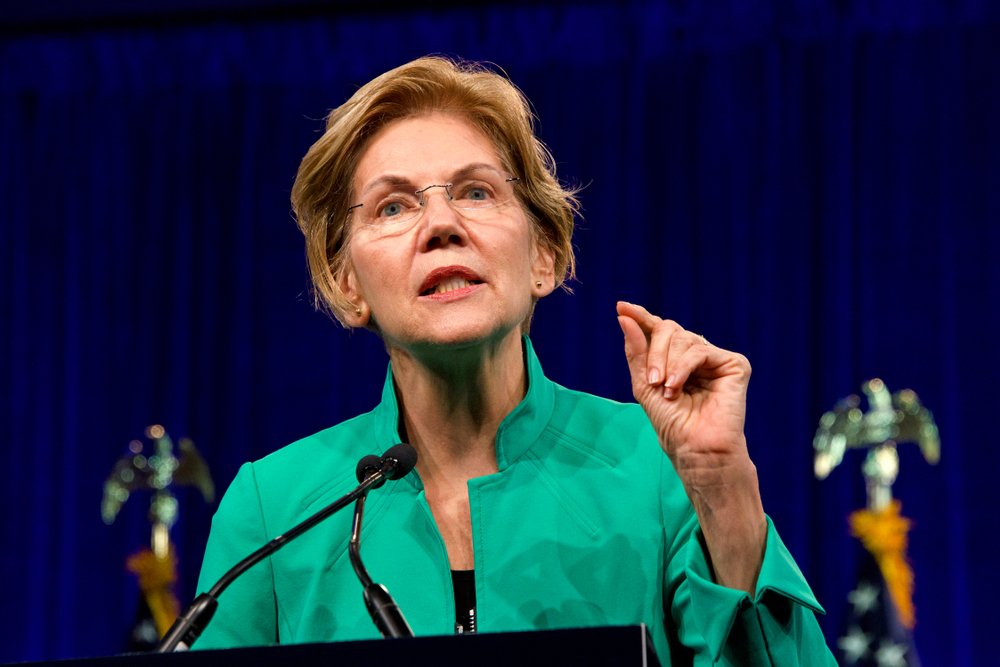This piece originally appeared in FIN, James Ledbetter’s fintech newsletter.
It’s merely an impression, but it feels like the climate criticism of cryptocurrency mining has been less prominent in the second half of 2021 than in the first half, even as cryptocurrency itself has continued to skyrocket. In May, for example, the New York State legislature considered a bill that would have imposed a three-year moratorium on cryptocurrency mining until an environmental impact study could be concluded. That bill died quickly, and there’s been not much formal action since then. In part, this may be because the crypto industry has been on a global lobbying offensive this year, successfully circulating the message that blockchain technology could help boost growth in renewable energy.
US Senator Elizabeth Warren (D-MA), however, is not having it.
This week she sent a remarkably detailed letter to Jeffrey Kirt, the CEO of Greenidge Generation Holdings, a publicly traded Bitcoin mining company headquartered in Dresden, New York, in the Finger Lake region. Warren asked for information about Greenidge’s operations and “the resulting impacts on the environment and local communities.” What makes Greenidge especially interesting—and this is starting to become common among large Bitcoin miners—is that the company doesn’t merely use energy by mining Bitcoin, it also produces the energy, in its case primarily through natural gas, and sells some to state residents.

For Warren, this might represent the worst of both worlds, energy and crypto. The Senator strongly implied that Greenidge’s stated commitment to sustainability is, at best, lip service: “Your company claims carbon neutrality through the purchase of carbon offsets, but its Dresden facility is still putting hundreds of thousands of metric tons of carbon dioxide into the atmosphere that would not be emitted otherwise.”
Greenridge is, to put it mildly, an unusual company. It describes itself as a “vertically integrated Bitcoin mining company,” but Greenidge only began commercial Bitcoin mining last year. It grew out of a consortium of coal plants in upstate New York that date back to the 1930s. A lack of electricity demand bankrupted the plant in 2011, but it reopened a few years later and converted to natural gas. The company has faced pressure around the state air permits for its main plant but, intriguingly, it has strong public support from the local electrical workers’ union. Earlier this year, Greenidge also purchased a public company called Support.com, which operates remote call centers.
You might think that a company at the heart of the cryptocurrency explosion would be, well, minting money. In reality, though, Greenidge is fairly small and, while growing fast, unprofitable. In the third quarter, Greenidge mined 729 Bitcoins, not quite 3x what it mined the year before. At current prices, that comes out to about $36 million. Given Bitcoin’s market capitalization of about a trillion dollars, you get a strong sense of how decentralized Bitcoin mining is. Greenidge is not only far from being a global leader in Bitcoin mining, it’s not even the largest in the US. (That honor would appear to belong to the Whinstone mine in rural Texas; in October CNBC.com reported that it was mining more than 500 Bitcoin a month.) Greenidge’s most recent earnings statement showed a Q3 loss of about $8 million on revenues of $35.75 million. Greenidge did not respond to FIN’s request for comment.

Nonetheless, the company clearly plans for meteoric growth, which provides some basis for Warren targeting it; Greenidge is also planning to open a power/mining plant in Spartanburg, South Carolina. FIN predicts that it’s going to be a while before Greenidge responds. Warren’s six-page, single-spaced letter delves pretty deeply into the details that one might expect from a former law professor. For example:
How does your impingement data compare to the Environmental Protection Agency’s (EPA) proposed numeric performance standard of limiting fish impingement mortality to no more than 12% on an annual average and 31% on a monthly average, and how does your entrainment data compare to the EPA standard for new units of reducing entrainment mortality to the equivalent of 90% of reductions achieved by closed-cycle cooling?
Warren’s legislative goal here is unclear, especially because this Congress seems unlikely to pass any new laws cracking down on crypto mining. Still, it’s far from impossible to envision a future in which large renewable energy companies generate power for free for their local grids, and subsidize that social goal by mining cryptocurrency. After all, cities like Miami have already made millions by issuing their own crypto coins. If Warren’s grilling can push toward that outcome, then let’s see more of it.
Wise Storms the US
Wise is one of Europe’s most successful fintech startups (OK, it’s based in London, but back when it launched in 2011 and was known as TransferWise, London was still part of Europe, plus the founders are from Estonia). Wise made a splash by offering crossborder currency exchanges at rates far lower than traditional banks and, while the company has had a bumpy ride since going public in July, it’s been profitable for years and is one of very few European fintechs worth billions of dollars.
Now, Wise is making a serious push into the North American market. This week, the company launched a “Wise card” in Canada that allows customers to spend money in US dollars and other currencies without any transaction fees. Wise also announced that it is opening a major office in Austin.
Currently, about a fifth of Wise’s business is in North America, but the company is pushing for more. Wise CTO Harsh Sinha told FIN “the US is one of our fastest-growing markets, and obviously a very large market.” Sinha says Wise chose Austin in part because “there are a lot of people who are a little bit fed up with the Bay Area.”
How much does it matter to Wise that, especially since the COVID pandemic, Americans travel less outside their own monetary borders than Brits and Europeans do? Sinha acknowledges the issue, but argues that 1) younger Americans are more internationally focused, and 2) Leisure travel per se is a limited use case. Wise will focus on businesses and remittance payments in the US market.
Even so, N26’s very recent abandonment of the US market has to give any outside fintech companies pause. Sinha makes a very reasonable point that for a banking relationship to work, many people psychologically need to feel that their money is somehow close by (there are a few large multinational banks with prominent roles in the US, including Banco Santander and HSBC, but Sinha maintains that they function as if they were domestically controlled). By contrast, he argues, a payments/transfer business is intrinsically virtual, and consumers will be attracted to a good deal.
This piece originally appeared in FIN, James Ledbetter’s fintech newsletter. Ledbetter is Chief Content Officer of Clarim Media, which owns Techonomy.
















